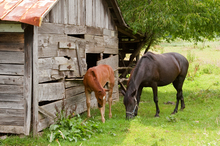Throughout the world, horses and other equines usually live outside with access to shelter from the elements. During the spring and summer seasons, when horses are often put out to pasture, horse owners should be aware of their horse's needs and be vigilant in making sure horses are protected from dehydration, flies, accidental injuries and infectious diseases.

Keeping horses healthy
During spring and summer seasons, when horses are put out to pasture, horse owners should be aware of the horse's needs and be vigilant in making sure horses are protected from dehydration, flies, accidental injuries and infectious diseases.
Horses must have access to clean fresh water at all times, and access to adequate forage such as grass or hay. Unless equines can be fully maintained on pasture with a natural open water source, horses must be fed daily. As horses evolved as continuous grazers, it is better to feed small amounts of grain throughout the day than to feed a large amount of grain at one time.
As equines are herd animals, most have better mental behavior when in proximity to other equine company. However, this is not always possible, and it has been known for companionship bonds to develop between horses and cats, goats and other species. There are exceptions. Some horses, particularly stallions may need to live on their own as they may fight with other animals.
Horses that are not on full-time turnout in a field or pasture normally require some form of regular exercise, whether it is being ridden, longed or turned out for free time. However, if a horse is ill or injured it may need to be confined to a stable, usually in a box stall.
In the monthly "Bits and Bytes" column, the Equine Expert at My Horse University offers the 7 following tips for insuring that your horse is healthy and active:
- Horses should be about a Body Condition Score of 5 over a 9 point scale.
- Daily feed intake for a horse at maintenance is about 1.5 to 2.0% of body weight on a dry matter basis.
- Monitor horses on spring pastures to prevent overeating and overgrazed pastures.
- If you have horses that are at risk of laminitis, they should wear a grazing muzzle.
- Provide more forage by rotating animals through small sections of your pasture.
- Try to purchase the hay you will need to for the coming winter this spring and early summer.
- Make sure your horses have shelter from the elements – sun, precipitation, and wind.
